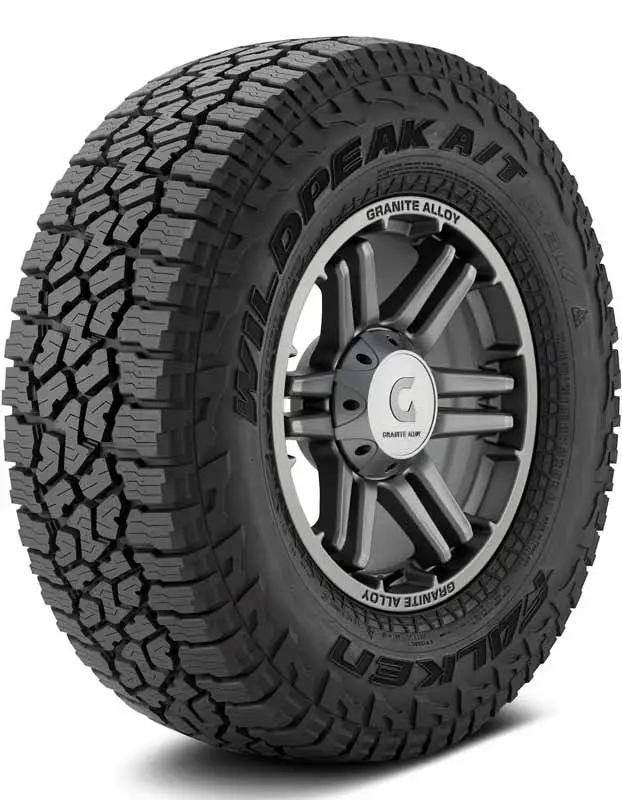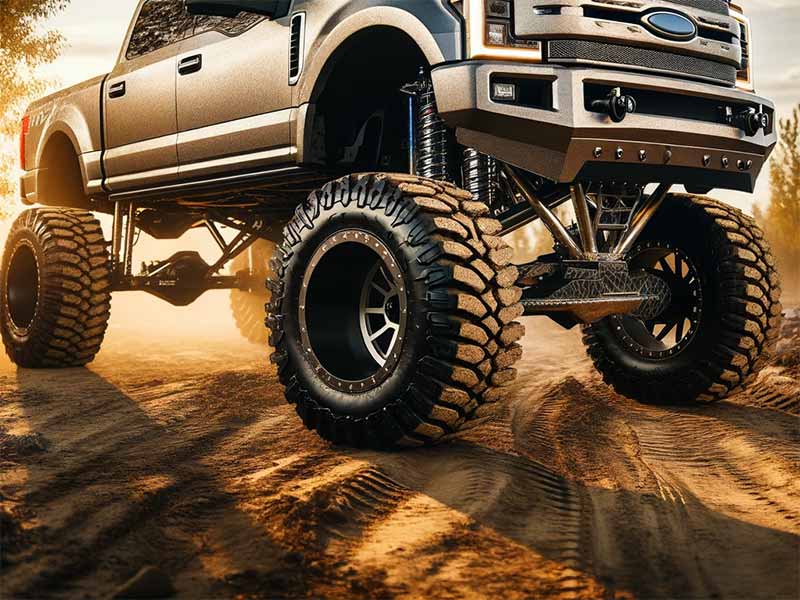Imagine you’re planning an off-roading adventure or upgrading your truck with a new lift kit. You’re browsing through tire options and keep coming across measurements in inches – a language of its own in the off-roading world.
Tire Size Conversion To Inches
Our conversion calculator simplifies tire size conversion to inches. It converts the standard tire size format (example 265/75R16) into three measurements:
- Tire height in inches
- Tire width in inches
- Wheel diameter in inches
Example Result 32×10.5×16
In this article, we delve into the nuts and bolts of tire size conversion to inches. We’ll guide you through understanding standard tire sizes, converting widths and heights, and making sense of wheel diameters, all tailored for the off-roading enthusiast and lifted truck owner.
Standard Tire Size To Inches Converter
Understanding Standard Tire Size Format
Tire sizes can look like a jumble of numbers and letters, but each part tells a specific story about the tire. A common tire size might read something like P225/70R16. Let’s break this down:
- Type of Vehicle:
- The first letter indicates the type of vehicle the tire is intended for.
Pstands for ‘passenger vehicle.’- You might also see
LTfor ‘light truck,’ which is common for off-road tires.
- Tire Width:
- The three digits after the letter represent the width of the tire from one sidewall to the other.
- In our example,
225means the tire is 225 millimeters wide.
- Aspect Ratio:
- After the slash, the next two digits are the tire’s aspect ratio.
- This number, expressed as a percentage, represents the height of the tire’s cross-section to its width.
- So,
70means the height is 70% of the tire’s width.
- Construction Type:
- The letter following the aspect ratio indicates the tire’s construction.
Rstands for radial, which means the layers run radially across the tire.- Radial tires are the most common type you’ll encounter.
- Wheel Diameter:
- Finally, the last two digits tell us the size of the wheel that the tire fits.
- In this case,
16means the tire fits on a 16-inch wheel diameter.

Metric Tire Sizes For A Given Height
Sometimes you just want to know what tire size equals a certain number of inches high. Confusingly, there are many combinations that can equal the same height. This calculator helps simply things so you can easily find sizes that will work for your unique requirements.
Conversion Fundamentals
Now that we’re familiar with the standard tire size format, let’s shift gears and talk about converting these measurements to inches. Whether you’re scaling rocky terrains or navigating through muddy trails, understanding how to translate millimeters to inches will keep you rolling smoothly.
Let’s break down the basics of conversion.
Metric to Inches: The Basics
First things first, let’s address the metric-to-inch conversion. Most tire measurements are given in millimeters, but in the world of off-roading and custom trucks, inches are king. Here’s what you need to know:
- Conversion Factor:
- One inch equals 25.4 millimeters.
- To convert millimeters to inches, divide the millimeter measurement by 25.4.
- Tools for Conversion:
- A simple calculator will do the trick.
- There are also plenty of online conversion tools and charts available for quick reference.
Converting Tire Width to Inches
The width of a tire, given in millimeters, is perhaps the most crucial measurement for our conversion. This width affects not just the look of the tire, but its performance on different terrains. Here’s how to convert it:
- Simple Division:
- Take the tire width in millimeters and divide it by 25.4 to get the width in inches.
- For example, a tire width of 225mm would be 225 ÷ 25.4, equaling approximately 8.86 inches.
- Practical Implications:
- Knowing the tire width in inches helps in understanding the tire’s footprint and its suitability for various off-road conditions.

Calculating Tire Height in Inches
Venturing further into the realm of tire size conversion, let’s tackle the aspect of tire height. This is where things get really interesting for off-road enthusiasts and truck owners.
The Role of Aspect Ratio
The aspect ratio of a tire, as we discussed earlier, is the height of the tire’s sidewall expressed as a percentage of its width. This percentage is crucial for calculating the tire’s overall height. Here’s how it works:
- Formula for Sidewall Height:
- To calculate the sidewall height in inches, multiply the tire width (already converted to inches) by the aspect ratio percentage and then divide by 100.
- For example, if a tire is 225mm wide (8.86 inches after conversion) and has an aspect ratio of 70, the sidewall height is 8.86 inches * 70% ÷ 100, which equals about 6.20 inches.
Total Tire Height
Once you’ve got the sidewall height, calculating the total height of the tire is just a step away. Remember, the tire’s height includes the height of the sidewalls on both sides and the wheel diameter. Here’s how you add it all up:
- Full Height Calculation:
- Double the sidewall height (since there are two sidewalls, top and bottom) and add the wheel diameter (already in inches).
- Continuing our example, if the wheel diameter is 16 inches, the total tire height would be (6.20 inches * 2) + 16 inches, equaling approximately 28.40 inches.

Understanding Wheel Diameter
As we continue our journey through tire size conversion, it’s time to talk about wheel diameter. This is the one aspect of tire size that’s already conveniently provided in inches, making our job a bit easier.
Wheel Diameter: The Inch-Perfect Measurement
The wheel diameter, which is the last number in the standard tire size format, is straightforward. It’s the size of the wheel from one edge to the other, measured through the center.
Here’s what you need to know:
- Already in Inches:
- The wheel diameter in the tire size (e.g., the
16in P225/70R16) is already in inches. - No conversion is needed here!
- The wheel diameter in the tire size (e.g., the
The Role of Wheel Diameter in Tire Selection
While the wheel diameter might not need converting, its importance cannot be understated, especially for off-roaders and truck enthusiasts. Here’s why it matters:
- Fit and Compatibility:
- The diameter determines what size wheel the tire can fit on.
- It’s essential to match the tire’s wheel diameter with the diameter of the wheels on your vehicle.
- Impact on Performance and Aesthetics:
- Larger wheel diameters can give a more aggressive look, popular in many off-roading circles.
- It also affects the ride quality – larger wheels might offer a firmer ride, while smaller diameters can lead to a softer, more cushioned experience.
Comprehensive Conversion Examples
Now that we’ve navigated through the nuances of tire size conversion, it’s time to put all this knowledge into action. In this section, we’ll walk through a few examples, showing the full conversion process for different tire sizes.
Example 1: 265/75R16 In Inches
- Tire Size: P265/75R16
- Width Conversion: 265mm / 25.4 = approximately 10.43 inches
- Aspect Ratio Calculation: 75% of 10.43 inches = 7.82 inches (sidewall height)
- Total Tire Height: (7.82 inches * 2) + 16 inches (wheel diameter) = 31.64 inches
- Summary: A P265/75R16 tire is about 10.43 inches wide and 31.64 inches tall.
Example 2: 315/70R17 In Inches
- Tire Size: LT315/70R17
- Width Conversion: 315mm / 25.4 = approximately 12.40 inches
- Aspect Ratio Calculation: 70% of 12.40 inches = 8.68 inches (sidewall height)
- Total Tire Height: (8.68 inches * 2) + 17 inches (wheel diameter) = 34.36 inches
- Summary: An LT315/70R17 tire is around 12.40 inches wide and 34.36 inches tall.
Example 3: 285/65R18 In Inches
- Tire Size: P285/65R18
- Width Conversion: 285mm / 25.4 = about 11.22 inches
- Aspect Ratio Calculation: 65% of 11.22 inches = 7.29 inches (sidewall height)
- Total Tire Height: (7.29 inches * 2) + 18 inches (wheel diameter) = 32.58 inches
- Summary: A P285/65R18 tire measures approximately 11.22 inches in width and 32.58 inches in height.
Wrapping Up: Practical Application
These examples demonstrate how to convert standard tire sizes into the inches format, which is more commonly used in off-roading and by owners of large trucks. Understanding these conversions is crucial for:
- Ensuring Proper Fit: Avoiding issues with tire clearance and vehicle handling.
- Customization: Making informed decisions about tire sizes for specific off-road needs or aesthetic preferences.
Speedometer Error Calculator
Additional Considerations
As we near the end of our journey through tire size conversion, it’s important to highlight a few additional considerations. These key points will help ensure that your tire selection process is as smooth and effective as possible, whether for off-roading purposes or for your lifted truck.
Let’s delve into these crucial aspects.
Checking Vehicle Specifications and Compatibility
- Manufacturer Guidelines:
- Always refer to your vehicle’s manufacturer specifications for maximum and minimum tire size recommendations.
- Adhering to these guidelines ensures safety and maintains vehicle performance.
- Suspension and Body Modifications:
- If your vehicle has been modified, such as with a lift kit, this might alter the recommended tire sizes.
- Consulting with a professional or the modification kit manufacturer can provide clarity.
Safety and Performance Factors
- Handling and Stability:
- The right tire size is crucial for maintaining the vehicle’s handling characteristics and stability, especially at higher speeds or on challenging terrains.
- Oversized tires might look impressive but can affect braking, acceleration, and cornering.
- Speedometer Accuracy:
- Changing tire size can impact the accuracy of your vehicle’s speedometer and odometer.
- Consider recalibrating these instruments to reflect the new tire size accurately.
Environmental and Legal Considerations
- Fuel Efficiency:
- Larger or wider tires can reduce fuel efficiency due to increased rolling resistance.
- Consider this aspect if fuel economy is a priority for you.
- Legal Requirements:
- Different regions may have legal restrictions on tire sizes and vehicle modifications.
- Ensure your tire choice complies with local laws to avoid fines or legal issues.
Resources
Below are some links you may find helpful when learning about tires:
- Tire size calculator & metric to standard size conversion tool – Quadratec
- Tire size equivalent chart for 33″, 35″, 37″ or 40″ tires – Tire Buyer
Final Thoughts
Understanding tire size conversion to inches is vital for anyone involved in off-roading or owning a lifted truck. It ensures that you select tires that not only fit your vehicle but also enhance its performance and appearance.
Remember, the right tire size affects everything from handling and stability to safety and aesthetics.
Good luck and happy motoring.




